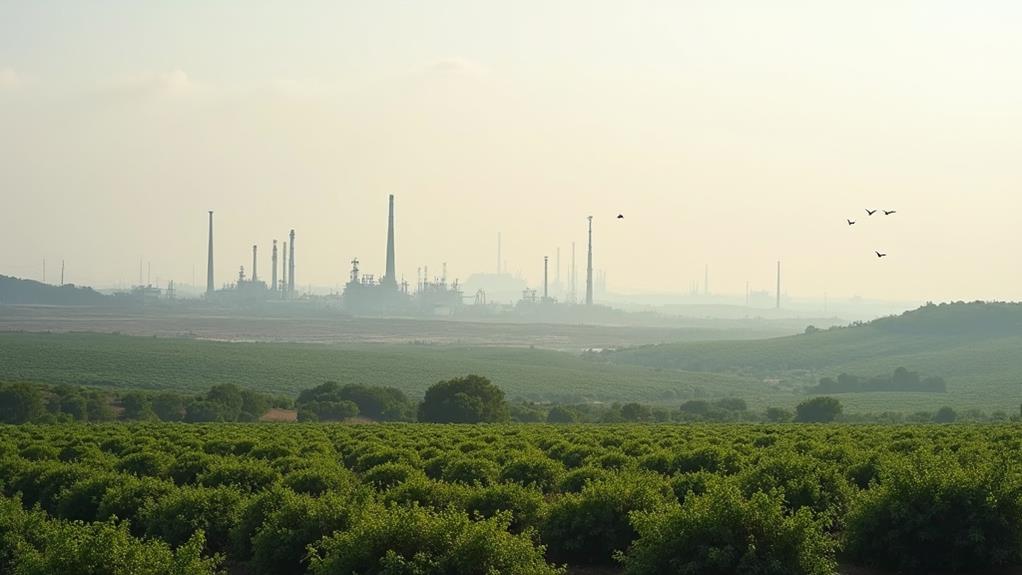As you indulge in the soothing scents of essential oils, the well-manicured fields of lavender and tea trees that produce them stand in stark contrast to the often hidden environmental damage behind their cultivation. Deforestation, soil degradation, and water pollution are just a few of the unintended consequences of the growing demand for these natural products. You're likely to be surprised by the extent of the ecological footprint left behind, and the question arises: can the benefits of essential oils be balanced with the need to protect the environment? The answer lies in understanding the complex web of factors at play.
Key Takeaways
- Essential oil production leads to widespread deforestation, habitat destruction, and increased greenhouse gas emissions.
- Precision agriculture and regenerative farming practices can minimize the environmental footprint of essential oil crop cultivation.
- Water conservation practices and drought-resistant crops can mitigate the strain on local water resources from essential oil production.
- Implementing effective waste reduction strategies and by-product utilization approaches can minimize the industry's ecological footprint.
- Prioritizing supplier accountability and transparency throughout the supply chain is crucial for assessing the environmental impact of essential oil production.
Environmental Impact of Cultivation
To mitigate these effects, you can adopt more sustainable farming practices.
Crop monitoring, for instance, can help you optimize water and fertilizer application, reducing waste and environmental harm.
By using advanced technologies like drones and satellite imaging, you can monitor crop health and growth in real-time, allowing for more targeted interventions.
Farm mechanization is another area where you can make a positive impact.
By investing in more efficient equipment and machinery, you can reduce fuel consumption and lower greenhouse gas emissions.
Additionally, adopting precision agriculture techniques can help minimize waste and reduce the environmental footprint of your essential oil crop cultivation.
Deforestation and Biodiversity Loss
The expansion of essential oil production has led to widespread deforestation and habitat destruction, as large tracts of land are cleared to accommodate the increasing demand for essential oil crops.
You'll notice that this trend is particularly pronounced in tropical regions, where forests are being cleared at an alarming rate. According to the Food and Agriculture Organization (FAO), the global forest area has declined by 13% since 1990, with the majority of this loss occurring in tropical regions.
As a result of deforestation, you're likely to see increased forest fragmentation, which can have devastating effects on local ecosystems.
When forests are fragmented, it can lead to the isolation of tree species, making them more vulnerable to extinction. In fact, the International Union for Conservation of Nature (IUCN) estimates that up to 100,000 tree species are threatened with extinction, many of which are found in tropical regions.
The loss of these tree species can have cascading effects on entire ecosystems, leading to a decline in biodiversity and ecosystem function. As you examine the environmental impact of essential oil production, it's crucial to weigh the role of deforestation and habitat destruction.
Soil Degradation and Erosion
When you assess the environmental impact of essential oil production, you find that farming practices play a significant role in soil degradation and erosion, with intensive cultivation and monoculture leading to soil compaction and nutrient depletion.
As you consider the effects of deforestation and land conversion for essential oil crops, it becomes clear that the removal of native vegetation increases soil vulnerability to erosion, especially in areas with high rainfall or steep slopes.
Farming Practices Effects
Essential oil production's environmental footprint is substantially influenced by farming practices, particularly those that lead to soil degradation and erosion.
As you assess the effects of farming practices on soil health, consider the benefits of implementing sustainable methods. Crop rotation and intercropping are two strategies that can markedly reduce soil degradation.
By rotating crops, you can break disease and pest cycles, improving soil fertility and structure. Intercropping, on the other hand, promotes biodiversity and reduces soil erosion by placing multiple crops in close proximity.
Research has shown that crop rotation can increase soil organic matter by up to 20% and reduce erosion by up to 50%. Intercropping has also been found to reduce soil erosion by up to 30% and increase crop yields by up to 25%.
By adopting these practices, essential oil producers can minimize their environmental impact while maintaining productivity. Vital to recognize is that these strategies may require adjustments to existing farming systems, but the long-term benefits to soil health and the environment make them well worth the investment.
Deforestation and Land
Upon closer examination of the environmental impact of essential oil production, it becomes clear that deforestation and land use play a pivotal role in exacerbating soil degradation and erosion.
You'll find that widespread deforestation, often resulting from land grabbing, contributes substantially to soil erosion. When forests are cleared, the soil's natural protective layer is removed, leaving it vulnerable to erosion.
This can lead to soil degradation, reduced fertility, and decreased essential oil yields.
Forest fragmentation, a consequence of deforestation, further exacerbates soil erosion. As forests are fragmented, the remaining trees struggle to maintain soil stability, and erosion increases.
This can result in increased sedimentation in waterways, decreased water quality, and negative impacts on local ecosystems.
Research suggests that every 1% increase in deforestation can lead to a 0.4% increase in soil erosion.
Water Pollution and Conservation
The cultivation and distillation of essential oil-bearing plants can strain local water resources and lead to water pollution.
As you evaluate the environmental impact of essential oil production, it is vital to take into account the effects on aquatic ecosystems. Water pollution from essential oil production can result from the use of agrochemicals, such as pesticides and fertilizers, which can contaminate nearby water sources.
Additionally, the distillation process requires large amounts of water, which can strain local water resources, particularly in areas where water is already scarce.
Implementing water conservation practices can help mitigate these impacts. You can adopt irrigation systems that use recycled water or implement rainwater harvesting techniques. Furthermore, using drought-resistant crops can reduce the need for irrigation.
Energy Consumption and Emissions
When you consider the energy consumption patterns associated with essential oil production, it's clear that resource utilization varies widely depending on the specific oil being produced.
For instance, the distillation process required for high-volume oils like lavender and tea tree oil typically requires significant amounts of steam, resulting in substantial greenhouse gas emissions.
Greenhouse Gas Emissions
How much energy is actually required to produce essential oils, and what's the resulting greenhouse gas footprint?
To answer this, let's examine the energy consumption patterns in essential oil production.
A study on lavender oil production revealed that distillation, the primary process for extracting essential oils, accounts for approximately 55-60% of total energy consumption.
You'll notice that this energy consumption pattern translates to significant greenhouse gas emissions.
For instance, a kilogram of lavender oil production results in around 11-15 kilograms of CO2 equivalent emissions.
The main contributor to these emissions is the combustion of fossil fuels for distillation and other energy-intensive processes.
To mitigate this impact, essential oil producers and consumers can explore carbon offsetting strategies, such as investing in renewable energy projects or reforestation initiatives.
Resource Consumption Patterns
In terms of resource consumption patterns, you're likely to find that essential oil production relies heavily on non-renewable energy sources.
This reliance is mainly driven by the need for large amounts of energy to power distillation processes, transportation, and other operations.
According to recent studies, the energy consumption patterns of essential oil production can be broken down as follows:
- Distillation: 70-80% of total energy consumption is attributed to the distillation process, which is often powered by fossil fuels.
- Raw material sourcing: 10-15% of energy consumption is linked to the sourcing and transportation of raw materials, including seeds, leaves, and other plant-based materials.
- Supply chain analysis: 5-8% of energy consumption is attributed to supply chain activities, including packaging, storage, and distribution.
- Agricultural practices: 2-5% of energy consumption is linked to agricultural practices, such as irrigation and fertilization.
Waste Management and Disposal
The essential oil industry generates substantial amounts of waste, primarily in the form of plant biomass, distillation residues, and packaging materials.
As you assess the environmental impact of essential oil production, it's vital to examine waste management and disposal strategies. Implementing effective waste reduction strategies can markedly minimize the industry's ecological footprint.
For instance, adopting by-product utilization approaches can transform waste into valuable resources. By-product utilization involves reusing or recycling waste materials to produce other products, such as biofuels, animal feed, or fertilizers.
This approach can reduce waste disposal costs and generate additional revenue streams for essential oil producers. Furthermore, by-product utilization can help decrease greenhouse gas emissions associated with waste decomposition and disposal.
You can also look into alternative waste management methods, such as composting or anaerobic digestion, to further reduce the industry's environmental impact. By adopting these strategies, essential oil producers can minimize waste, reduce environmental degradation, and promote sustainable practices throughout the supply chain.
Effective waste management and disposal practices are essential for mitigating the environmental impact of essential oil production.
Sustainable Production Methods
When exploring sustainable production methods in essential oil production, you'll likely consider organic farming practices that minimize synthetic pesticide and fertilizer use, reducing soil and water pollution.
You may also investigate the implementation of renewable energy sources, such as solar or biogas power, to fuel distillation and other production processes.
Organic Farming Practices
Organic farming practices are increasingly being adopted in essential oil production as a sustainable method to minimize environmental impact.
You're likely to benefit from adopting organic farming practices in your essential oil production, as they promote environmentally friendly techniques and reduce your reliance on synthetic chemicals.
When you adopt organic farming practices, you'll notice several benefits, including:
- Improved soil health: Organic farming promotes the use of natural methods to improve soil health, such as crop rotation and composting.
- Increased farm autonomy: Organic farming encourages self-sufficiency, allowing you to rely on your own resources rather than external inputs.
- Reduced water pollution: Organic farming methods reduce the risk of water pollution, as you'll avoid using synthetic chemicals that can contaminate water sources.
- Enhanced biodiversity: Organic farming promotes biodiversity, as you'll create a more diverse and resilient ecosystem.
Renewable Energy Sources
Renewable energy sources are increasingly being integrated into essential oil production to reduce the industry's reliance on fossil fuels and lower its carbon footprint.
As you assess the environmental impact of essential oil production, you'll find that solar power and wind energy are two of the most promising alternatives.
Solar power, for instance, can be used to generate electricity for distillation, irrigation, and other production processes.
A study by the National Renewable Energy Laboratory found that solar-powered distillation can reduce energy consumption by up to 75% compared to traditional methods.
You can also consider wind energy as a viable option for powering essential oil production.
Wind turbines can be installed on-site to generate electricity, reducing reliance on the grid and lowering carbon emissions.
According to the American Wind Energy Association, wind energy can reduce greenhouse gas emissions by up to 2.2 billion metric tons annually.
By integrating solar power and wind energy into your essential oil production, you can substantially reduce your environmental impact and contribute to a more sustainable industry.
This shift towards renewable energy sources can also help you stay competitive in a market that's increasingly prioritizing sustainability.
Certification and Labeling Standards
Certifications are based on industry standards and regulatory frameworks that govern environmental sustainability and social responsibility.
Some of the key certifications to look for include:
- ISO 9001: A quality management system standard that guarantees essential oil production meets quality and environmental standards.
- GMP (Good Manufacturing Practice): A standard that guarantees essential oil production meets quality and safety standards.
- ECOCERT: A certification that verifies essential oil production meets organic and sustainable standards.
- Fair Trade: A certification that verifies essential oil production meets fair labor standards.
When evaluating the environmental impact of essential oil production, look for certifications that align with your values and standards.
Supply Chain Transparency
Evaluating the environmental impact of essential oil production also requires examining the supply chain.
As you assess the supply chain, you'll likely encounter complex networks of farmers, processors, and distributors. This complexity can lead to traceability issues, making it difficult to track the origin and movement of essential oils.
To address these issues, you should prioritize supplier accountability.
When evaluating suppliers, you should look for third-party certifications, such as Fair Trade or Organic, which promote transparency and accountability.
You should also assess suppliers' environmental and social policies, including their water and energy usage, waste management, and labor practices.
Additionally, you should establish clear communication channels with suppliers to monitor their practices and address any concerns.
Eco-Friendly Alternatives and Solutions
As you seek to minimize the environmental footprint of essential oil production, exploring eco-friendly alternatives and solutions becomes a crucial step.
This involves adopting sustainable practices throughout the supply chain, from sourcing to packaging.
Key Alternatives and Solutions
1. Green packaging: Consider switching to biodegradable or recyclable packaging materials to reduce waste and minimize environmental impact.
This can include using glass bottles, cardboard, or plant-based packaging materials.
2. Conscious consumerism: Educate yourself and others about the environmental implications of essential oil production.
This can help drive demand for sustainable and eco-friendly essential oils.
3. Regenerative farming: Promote regenerative farming practices that prioritize soil health, biodiversity, and efficient water use.
This can help reduce the environmental impact of essential oil production.
4. Upcycling and repurposing: Explore creative ways to upcycle or repurpose essential oil waste products,
such as using leftover plant materials for compost or animal feed.
Frequently Asked Questions
Can Essential Oils Be Produced Without Harming Animals?
You can produce essential oils without harming animals by opting for plant-based sources and avoiding products tested on wildlife, consequently supporting wildlife conservation efforts and reducing animal testing in the industry altogether.
Are Genetically Modified Plants Used in Essential Oil Production?
Can you imagine essential oils derived from genetically engineered plants? Yes, you're likely using them, as some essential oil producers utilize GM crops and gene editing techniques to enhance yields and disease resistance.
Can Essential Oils Be Used as Natural Pesticides?
You use essential oils as natural pesticides, leveraging their bioactive compounds to deter pests. Research shows varying pesticide efficacy, making them suitable for organic farming, but their use requires careful application and targeting specific pest species.
Do Essential Oils Contribute to Indoor Air Pollution?
You're about to diffuse your favorite essential oil, but do you know what's really being released into the air? Yes, essential oils can contribute to indoor air pollution if your ventilation systems aren't up to par.
Can Essential Oil Waste Be Used as Compost?
You can repurpose essential oil waste as compost, but it's vital to analyze its composition first. Properly processed waste can enhance soil enrichment and aid in waste reduction, benefiting your garden's ecosystem with nutrient-rich organic matter.
Conclusion
As you weigh the environmental impact of essential oil production, it's clear that adopting sustainable methods is vital. Like a ship changing course, the industry must shift towards eco-friendly practices to avoid a catastrophic collision with the environment. By embracing regenerative farming, precision agriculture, and energy-efficient distillation, the industry can markedly reduce its ecological footprint. Transparency, certification, and conscious consumerism will be key in driving demand for sustainable essential oils and mitigating the sector's environmental harm.














